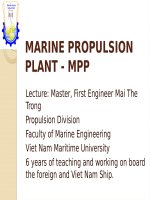BÀI GIẢNG TRANG TRÍ hệ ĐỘNG lực CHƯƠNG 3(ENGLISH)
Bạn đang xem bản rút gọn của tài liệu. Xem và tải ngay bản đầy đủ của tài liệu tại đây (3.88 MB, 50 trang )
CHAPTER 3:
MODE OF DRIVING
AND DRIVING MECHANISMS
IN THIS CHAPTER WE HAVE THE FOLLOWING UNITS:
UNIT 3.1: FUNCTION AND CLASSIFICATION
UNIT 3.2: DIRECT DRIVING MODE
UNIT 3.3: INDIRECT DRIVING MODE
UNIT 3.4: SPECIAL DRIVING MODE
UNIT 3.5: HYDRAULIC DRVING EQUIPMENT
UNIT 3.6: FRICTION CLUTCH
UNIT 3.7: REDUCTION GEAR
UNIT 3.1: FUNCTION AND CLASSIFICATION
1. Driving equipment and its function.
Driving equipment is used to transmit power from the main engine to
the propeller.
Driving equipment consist of:
- Shafting: Intermediate shaft, thrust shaft and propeller shaft.
- Bearings: Intermediate bearings, thrust bearing and stern bearings
- Shaft coupling.
- Clutch, reduction gear (intermediate equipment)
- Electric transmission equipment.
2. Classification.
Today, there are three kinds of driving modes for ships. They are:
- Direct driving mode.
- Indirect driving mode.
- Special driving mode.
UNIT 3.2: DIRECT DRIVING MODE
ME
FPP PROPELLER FACTORY
1. Feature
♥
♥
♥
♥
There is not any intermediate equipment between the
main engine and the propeller. Direct driving is carried
out only by the shafting.
Revolution of the propeller is the same the main engine
revolution.
It is commonly applied on the large and medium-sized
ships when revolution of the main engine is about 85 ÷
300 rpm.
In a direct driving propulsion plant, the main engine is a
kind of low-speed, large power, direct reversing diesel
engine. The most common is low-speed; two- strokes
cycle diesel engine with crosshead.
2. Advantages
♪
Driving efficiency is high. It does not have any loss other than friction loss in the
bearings. A direct driving propulsion plant with short shafting will have a driving
efficiency of about 97 - 98%.
♪
The main engine has low specific fuel consumption.
♪
The propeller efficiency is high (because revolution of the main engine is the same
as the optimum range of the propeller revolution).
♪
Its structure is simple and easy to maintain. It is safe in working, reduce noise and
vibration and has high longevity.
3. Disadvantages
♪ The main engine has large dimensions and weight so dimensions and
weight of the propulsion plant are increased, transportation ability of
the ship is reduced. The direct driving mode is not suitable for ships
with small displacement, or height of the engine room is limited.
♪ To reverse direction of the propeller, the main engine must be
reversed so it is not flexible.
♪ The direct driving mode is suitable for tanker ships, general cargo
ships.
UNIT 3.3: INDIRECT DRIVING MODE
Clutch
Gear-box
ME
Figure 1.16. ME driving a propeller through gear-box
2. Advantages
Dimension and weight of the propulsion plant are small. It reduces
dimensions of the engine room and increases the cargo transportation ability of
the ship. At the same power, the weight of the high or medium-speed diesel
engine is 40% lighter than a low-speed diesel engine.
The same type of diesel engine can be used for many kinds of ships that
have different propeller revolution rates.
It is not necessary to directly reverse the main engine for reversing direction
of the ship. This can be done by the multi-stage reduction gear therefore, the
flexibility of the propulsion plant and the longevity of the main engine will be
increased.
Two or more main engines can be used to drive only one propeller, thus
increases the flexibility of the propulsion plant and the main engines can be
effectively operated in every operating condition (even when light load).
3. Disadvantages
Transmission efficiency is lower than the direct driving.
It is complex and difficult to operate, maintain and repair.
Longevity is shorter.
The indirect driving mode is more suitable for naval ships, passenger ships
and container ships.
UNIT 3.4: SPECIAL DRIVING MODE
THE SPECIAL DRIVING MODE CONSIST OF:
ELECTRIC DRIVING
CONTROLABLE PITCH PROPELLER
DRIVING
I. Electric driving.
1. Feature
- There is no mechanical connection between the main
engine and the propeller.
- There are two times of energy transformation.
M/E
Gen
Motor
Figure: Schematic of Electric transmission propulsion plant
(ETPP)
2. Advantages
The same as the indirect driving mode, the main engine is usually a high or
medium-speed therefore, the dimension and weight of the propulsion plant is small
and thus reduces the dimensions of the engine room.
It is not necessary to reverse the main engine when reversing the direction of the
ship. This can be carried out by reversing the direction of the electric motor.
Therefore the longevity of the main engine and the flexibility of the propulsion
plant will be increased.
Revolution of the propeller can be changed while the main engine is still working
at a constant speed. This can be done by changing revolution of the motor.
Therefore the main engine can always be run at the most economic region.
It is not necessary to have a long shafting and many intermediate bearings, so the
main engine can be located in the best suitable position in the engine room.
When the ship is stably sailing on the sea, the main generator can satisfy a part of
the electric energy requirements of the ship.
3. Disadvantages
- Transmission efficiency is much lower than the two kinds listed above.
- Overload ability of the electric motor is less.
- It is complex, not economic and expensive.
- Longevity is shorter.
- Electric driving mode is more suitable for naval ships, fishing ships...
4. Electric driving diagram
This is the simplest illustration of the direct current electric driving
propulsion plant.
6
1
2
M
3
+
+
-
-
4
5
G
ME
Figure 3.1 Direct current electric driving propulsion plant
1- Electric Motor
2- Excited coil of the motor
3- Excited coil of the generator
4- Generator
5- Main engine
6- Rheostat
II. CONTROLABLE PITCH PROPELLER DRIVING
1. Structure and methods for controlling pitch of the propeller.
a. Structure
It consists of two main parts:
- Blades can be turned around their axis.
- Mechanism for controlling pitch of the propeller. This
mechanism is generally installed inside the propeller hub.
b. Methods for controlling pitch of the propeller
To vary pitch of the propeller, its blades must be turned around
their vertical axis. This movement is carried out by hydraulic or mechanical
means. Today, there are four common methods to control pitch of the
propeller; the illustrations are showed as below:
1
4
2
3
Figure 3.2: Methods for controlling pitch of the propeller
1- Gearing type
2- Turning type
3- Connecting rod type
4- Rack-and-pinion type
2 . Advantages
It is not necessary to change the rotating direction and revolution of the main
engine when reversing the direction and changing speed of the ship. This can be
done by controlling the pitch of the propeller.
The main engine is permitted to operate effectively even in heavy condition and
is protected from overload.
Flexibility and longevity of the propulsion plant are high.
3. Disadvantage
• Mechanisms are complex. The quality sealing of the propeller hub is required.
Therefore, it is very difficult to manufacture, assemble and repair. It is expensive.
• It is difficult to operate, especially determining the suitable working point between
the main engine and the propeller.
• If the pitch ratio (H/D) and the propeller revolution (np) are selected unsuitably,
the result power of the main engine is reduced.
• Knowledge of the operator is required.
• Controllable-pitch propeller driving becomes more suitable for use on naval ships,
passenger ships, and workshop ships, fishing ships, rescue ships.









